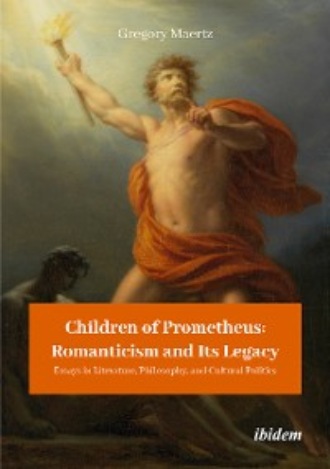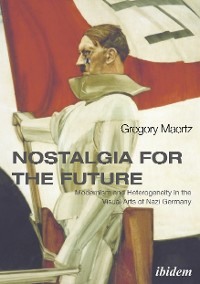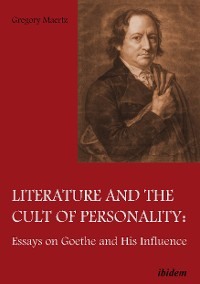
Полная версия
Children of Prometheus: Romanticism and Its Legacy
A further instance of Mary’s identification with the Monster is found in their similar responses to maternal deprivation. Victor and Reginald are also motherless, and for both this loss is exacerbated by the deaths of other loved ones. Anne Mellor has described Frankenstein as “an analysis of the failure of the family, the damage wrought when the mother—or a nurturant parental love—is absent.”26 This is also the central theme of St. Leon, which is, as already suggested, a transparent redaction of the Godwin family experience, and Mary’s treatment of the orphan’s agony of the Monster illustrates Sigmund Freud’s view that “missing someone who is loved and longed for is the key to an understanding of anxiety.”27 John Bowlby, the English psychologist and biographer of Charles Darwin, modifies Freud’s observations on grief and separation anxiety to suggest a possible cause of Mary’s frequent bouts of anxiety during her many pregnancies:
States of anxiety and depression that occur during adult years, and also psychopathic conditions, can, it is held, be linked in a systematic way to the states of anxiety, despair, and detachment . . . that are so readily engendered whenever a young child is separated for long from his mother figure, whenever he expects a separation, and when, as sometimes happens, he loses her altogether.28
By virtue of a kind of sorcery akin to alchemy, Mary and the Monster seem to have been formed by a hermaphroditic father, who combines both the male and female principles of generation and whose powers of multiplication correspond to the recondite powers of the philosopher’s stone. As a descriptive term “hermaphroditic” is preferable to William Veeder’s “androgyne,” since androgyny refers only to proclivity or “sexual character,” while hermaphroditism actually has reference to actual sexual nature or capacity.29 Victor’s ability to create life from inanimate matter and Reginald’s multiple rebirths by means of the elixir vitae are methods of creating life that circumvent the female body but not the maternal principle. In a thinly veiled disguise for Godwin’s relationship to Mary and her half-sister Fanny, Reginald outlives his wife and appropriates the maternal role in his relationship to his daughters. The life-giving powers exhibited by Victor and Reginald correspond to Mary’s own birth in which the maternal principle was eliminated in Wollstonecraft’s death. Through their traumatic births and status as orphans the Monster stands revealed as her fictive other.
The main narrative and thematic vehicle in both novels—the perversion or misuse of science, old and new—is, in fact, a distortion of procreation, and the bridge between alchemy and natural philosophy is the discovery of the means of creating or perpetuating life by a subtraction of the female principle from procreation. Ironically, the stain of mortality is removed from persons not of woman born. The elimination of the female principle in procreation invites Mary’s critique of the monstrosity of neglectful parenting. Testifying to the power of environmental conditioning in childhood, which is a fundamental teaching in Godwin’s Political Justice, both motherless protagonists reveal themselves to be neglectful parents in their own right. And Victor’s feckless record as the “parent” of the offspring of his scientific labors is symbolic of the neglectful male parents in Mary’s personal life—Godwin and Shelley, Victor rationalizes the abandonment of his child on grounds not usually associated with maternalism, that is, aesthetic criteria, insisting “that no mortal could support the horror of that countenance”; even a “mummy endued with animation could not be so hideous as that wretch.” (43) There are strong parallels here to Godwin’s “monstrous” behavior as a parent, for we know that he not only opposed Mary’s decision to elope with Shelley, but he also refused to claim or identify the body of Fanny Godwin following her suicide on October 9, 1816. (Like her half-sister, this doubly orphaned young woman had, in her father’s view, indelibly stained the family’s honor.) The novel also provides subversive commentary on the egregious behavior of other parents in the Shelley circle: Percy, Claire Clairmont, Byron, and even Mary herself. Byron gained custody of his daughter Allegra only to have her placed in a convent where she died of neglect. The frenetic wanderlust (and the woeful traveling conditions they endured) of the Shelleys may be directly implicated in the deaths of their children Clara I (March 6, 1815), Clara II (September 24, 1818), and William on June 7, 1819. Perhaps of all acts the most reprehensible was Shelley’s abandonment of Harriet and their children when he eloped with Mary. In what can only be reckoned a display of astonishing insensitivity, Percy and Mary were then married less than three weeks after Harriet, who was pregnant at the time, drowned herself in the Serpentine in Hyde Park. Considering this monstrous record of neglect, which clearly contravened the teachings of Godwin by which the Shelleys claimed to be fashioning their lives, the Chancery judgment delivered on March 17, 1817 denying Percy custody of his children with Harriet could have come as no surprise and, respecting the moral universe of both St. Leon and Frankenstein, was certainly justified.30
With the appropriation and rewriting of St. Leon Mary attains independence, as a creator of texts, from both her father and her husband. For her husband, she serves as an extension of her father; her elopement and marriage to Shelley represent efforts on his part to attain consanguinity with her father, his great idol, through the instrumentality of her mind and body. At the same time, it reflects Percy’s attempt to usurp Godwin’s role as Mary’s primary educator and literary precursor. We can see this as an attempted exclusionary gesture whose objective is to assume control over her continuing development as a writer. In Frankenstein Mary therefore seeks to perform a double divestiture not only of parental influence, but also of authoritative discourse associated with both dominating literary figures in her life, her father and her husband. In this way the novel serves as a powerful reminder that literary texts function instrumentally. In Holquist’s phrase, “they serve as a prosthesis of the mind. As such, they have a tutoring capacity that materially effects change by getting from one stage of development to another,” and in its dual capacity as an enabling device and as a necessary stage in the dialectic of education leading to the attainment of a secure authorial identity, Frankenstein enacts for its author and protagonists a dual process of soul and voice formation.31 Emulating Reginald’s and Victor’s search for ideal companionship, empowering knowledge and opportunities for doing some action that is “great and good,” the Monster’s odyssey begins with the discovery that he lives in a hostile world and that he has been rejected by his “father” and denied the right to engender his own offspring. His odyssey or Bildungsreise ends with the murderous inversion of Godwinian altruism as he lashes out at Victor, destroying all those with whom he enjoys emotional intimacy in order to render his condition identical to his own. The rebellion of the Monster, which proceeds from inarticulate rage to the discovery of speech and the art of discourse, invites comparisons with Mary’s efforts, first, to assimilate and, secondly, to overcome her father’s authoritative discourse, a process which culminates in her marriage to Shelley and the nearly simultaneous inception of her novel.
Recognizing that even the most persuasive interpretation may fail to convince, I would hesitate to suggest that the genesis and development of Mary’s novel is fully explained as the result of intertextual dialogue with Godwin’s St. Leon. Neither would I reduce the text’s function to mapping her development as a writer. But, as I have attempted to show, such an interpretation brings us closer to the novel’s textual and psychological matrices and it delineates the central autotherapeutic function of writing. Moreover, by adopting Bakhtin’s dialogic framework we gain a more pronounced awareness of the struggle involved in moving beyond mere appropriation of another’s authoritative discourse to the production of discourse that is distinctly one’s own. In contrast to those critics who have inserted Frankenstein into or extracted the novel from a patriarchal tradition, the preceding discussion should make it is possible to reject both alternatives. The tradition into which we should place Frankenstein is that which makes apparent its structure and language as empowering psychological scaffolding. Godwin’s St. Leon provided Mary with a dialogic partner in the struggle for self-expression, and Frankenstein is a reflection of the will to articulate her own consciousness and to attain individuation apart from the discourse associated with the “strong precursors” in her personal and literary experience. What makes the intertextual dialogue forming Frankenstein of particular interest is that the authoritative discourse with which its young author contended was formed by the texts of her father, mother, and husband—a body of texts that she habitually and even ritually read at home and on her mother’s grave in the St. Pancras churchyard. This is the tradition formed by St. Leon. From this perspective Mary’s novel can be seen to replicate intertextual dialogue with a text that we can readily identify, St. Leon, and because of Shelley’s filial relationship with its author, it is possible to extrapolate from this process of intertextual dialogue to her development and growth as a writer. The end result of this process is the acquisition and exercise of genuine cultural power.
1 Mikhail Bakhtin, The Dialogic Imagination: Four Essays. Ed. Michael Holquist. Trans. Caryl Emerson (Austin: University of Texas Press, 1982), 345.
2 In citing St. Leon but not pursuing the extensive thematic and plot correspondences with Frankenstein, recent studies follow Burton R. Pollin, “Philosophical and Literary Sources of Frankenstein,” Comparative Literature 17 (1965): 97–108. See, for example, Chris Baldick, In Frankenstein’s Shadow (Oxford: Clarendon Press, 1987), 37; Anne K. Mellor, Mary Shelley: Her Life, Her Fiction, Her Monsters (New York and London: Routledge reprint, 1989), 85; and Emily Sunstein, Mary Shelley: Romance and Reality (Baltimore: The Johns Hopkins UP, 1991, paperback edition), 23–24.
3 Emily Sunstein takes a neutral stance in the dispute over the character of the second Mrs. Godwin as compared to the first and reminds the reader that Mary’s singularly possessive attachment to her father was such that “no woman under Heaven, not even Mary Wollstonecraft had she descended from it, would have been readily accepted as her father’s consort by the four-year-old Mary Godwin,” Mary Shelley: Romance and Reality, 2.
4 The British Critic (July 1795), 95.
5 William Godwin, St. Leon: A Tale of the Sixteenth Century, 4 Volumes (London: Printed for G.G. & J. Robinson, R. Noble, printer, 1799), Vol. I, ix. Hereafter all intra-textual references are to this edition.
6 William Godwin, An Enquiry Concerning Political Justice (Third Edition, 1798), ed. Isaac Kramnick (Harmondsworth: Penguin Books, 1976), 762.
7 Baldick, op. cit., 26.
8 Mary Shelley, Frankenstein: or, The Modern Prometheus (1818 edition), in The Mary Shelley Reader, ed. Betty T. Bennett and Charles E. Robinson (New York: Oxford UP, 1990), 30. All intra-textual references are to this edition.
9 Masao Miyoshi, The Divided Self: A Perspective on the Literature of the Victorians (New York: New York UP, 1969), 86.
10 Gary Kelly is persuaded that Mary’s father “felt himself to be in possession of great and terrible secrets: the philosophy of Political Justice which he could not use for the benefit of mankind, but which, on the contrary, made him an object of fear and loathing,” The English Jacobin Novel, 1780–1805 (Oxford: Oxford UP, 1976), 209. Emily Sunstein (op. cit., 20) notes that Godwin’s contemporaries “compared him to a great, if failed explorer on humanity’s behalf, a Promethean paradigm that Mary Godwin would immortalize in her scientist, Frankenstein, whose confidant, Walton, is a polar explorer” and would-be altruist savior of mankind.
11 “The Female in Frankenstein,” in Feminism and Romanticism, ed. Anne K. Mellor (Bloomington, Indiana: Indiana UP, 1988), 224.
12 Journals of Mary Wollstonecraft Shelley. Abinger MSS, 21 (October 1838).
13 Emily Sunstein, Mary Shelley: Romance and Reality, 38–39: “All the children were deeply influenced by him, but Mary was his star disciple, the most powerfully engaged and permanently affected, the one from whom he demanded and gave most. Her most felicitous, intimate, even thrilling intercourse with her father was that of pupil and teacher, and most inordinate as her later tributes to him might seem, it was homage to mentorship that few fathers gave their daughters.”
14 Journals of Claire Clairmont, ed. M.K. and D. M. Stocking (Cambridge, Mass.: Harvard UP, 1968), 18.
15 Letter to W.T. Baxter, 8 June 1812 in Shelley and His Circle, 1773–1822, ed. Keith Neil Cameron and Donald H. Reiman (Cambridge, Mass.: Harvard UP, 1961–73), 3, 102.
16 Evidence for Mary’s idolization of her father is found in a letter: “Until I met Shelley, I may justly say that Godwin was my God,” The Letters of Mary Wollstonecraft Shelley, ed. Betty T. Bennet (Baltimore: The Johns Hopkins UP, 1980), 1, 296.
17 Anne K. Mellor, Mary Shelley: Her Life, Her Fiction, Her Monsters (New York and London: Routledge, 1989), 23.
18 Michael Holquist, Dialogism: Bakhtin and his World (New York and London: Routledge, 1990), 82.
19 Barbara Johnson, “My Monster/My Self,” Diacritics 12 (1982): 8.
20 From the author’s introduction, Mikhail Bakhtin, The Dialogic Imagination: Four Essays, xxxi.
21 Bakhtin, op. cit., 348.
22 I.M. Lotman, “On the Reduction and Unfolding of Sign Systems,” in Semiotics and Structuralism: Readings from the Soviet Union, ed. Henryk Baran (White Plains, NY: International Arts and Sciences Press, Inc., 1976), 302.
23 Bakhtin, op. cit., 345, 347.
24 All of these works figured prominently in Godwin’s scheme of education for his children, but Goethe’s Werther carried especially deep emotional resonance for the Godwin family because William was reading it at the time of Wollstonecraft’s death.
25 Regular visitors to the Godwin household included William Wordsworth, Charles Lamb, S.T. Coleridge, William Hazlitt, Thomas Holcroft, Joseph Johnson, Samuel Rogers, John Flaxman, J.M.W. Turner, Maria Edgeworth, Helen Maria Williams, and Charlotte Smith.
26 Mellor, op. cit., 39.
27 Sigmund Freud, Inhibitions, Symptoms and Anxiety (1926) in The Complete Psychological Works of Sigmund Freud (London: The Hogarth Press, 1953–1974), Vol. XX, 136–137.
28 John Bowlby, Attachment and Loss, Separation: Anxiety and Anger (New York: Basic Books, 1973), Vol. II, 4–5.
29 William Veeder, Mary Shelley and Frankenstein—The Fate of Androgyny (Chicago: U of Chicago Press, 1986).
30 See Chapter Six, “Deaths by Land and Sea,” in Robert Gittings and Jo Manton, Claire Clairmont and the Shelleys, 1798–1879 (Oxford: Oxford UP, 1992), 66–73.
31 Holquist, op. cit., p. 83.
Конец ознакомительного фрагмента.
Текст предоставлен ООО «ЛитРес».
Прочитайте эту книгу целиком, купив полную легальную версию на ЛитРес.
Безопасно оплатить книгу можно банковской картой Visa, MasterCard, Maestro, со счета мобильного телефона, с платежного терминала, в салоне МТС или Связной, через PayPal, WebMoney, Яндекс.Деньги, QIWI Кошелек, бонусными картами или другим удобным Вам способом.





